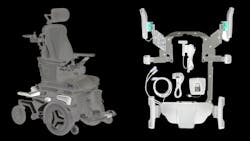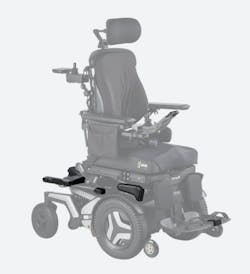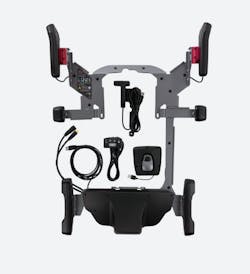Using Injection Molding to Design a “Smart” Wheelchair Fit for Family
Power wheelchair users have the potential to get hurt when their devices, which weigh hundreds of pounds, tip over or run into objects. For brothers Barry and Jered Dean, the danger was one that hit home as Barry’s daughter, Katherine, used a power wheelchair. When a family friend was sent to the hospital after a wheelchair fall, the Dean brothers set out to find a solution that would make his daughter’s chair safer while helping all power chair users avoid potential pitfalls.
What they came up with, along with a little manufacturing help from Protolabs, is LUCI, an attachable accessory system that brings smart technology to power wheelchairs for stability, security and connectivity.
LUCI’s hardware and software combine to give power wheelchairs a 360-deg. view of the world to avoid collisions and drop-offs, as well as warn of tipping dangers. Cloud-based communications alert loved ones of an accident and securely send user data to family and medical team members. LUCI incorporates stereo-vision cameras and infrared, ultrasonic and radar sensors in a patented, first-of-its-kind system that gets mounted between the seat and wheels of a power wheelchair.
After years of development, the Dean brothers began selling the LUCI system in early 2021. The system was quick to receive widespread recognition, its accolades including Time’s Best Inventions of 2020, Popular Science’s Best of What’s New, a CES 2021 Health & Wellness Innovation Award and Mobility Management’s “Smart Technology” Product Award.
Developing Fast, Creating “Invisible” Housings
In addition to their urgency to create a safer alternative for Katherine and other power wheelchair riders, the Deans’ announcement of their intent to develop such a product generated intense interest from wheelchair manufacturers.
For the speed and flexibility required, they turned to Protolabs for injection molding of plastic prototypes and production parts, as well as sheet metal fabrication for prototypes of the chair’s platform. The team required quick-turn parts because they were not only developing fast, but also with a lot of unknowns.
As a power wheelchair user steers LUCI with a joystick or other means, onboard sensors map the surroundings to avoid anything in the way, such as curbs, pets or people. The mapping technology includes millimeter-wave radar sensors that detect the range, velocity and angle of objects in the environment.
The plastic housings that contain the radar sensors posed a design challenge, Jered said, because those housings need to be “invisible” to the business card-sized radar sensors, while also being a certain shape, material and thinness to enable the radar devices to do their job of identifying potential hazards.
Another concern was finding a way to securely attach the plastic housings holding LUCI’s various sensors and electronics to the system’s Smart Frame. The frame is a sheet metal platform that is mounted between the seat and wheels of a new or existing power wheelchair to install the LUCI system.
Offering a user experience that merges rider intent and independence with the protection and assistance that LUCI’s technology provides also was a priority.
One expression of that needed to be through LUCI’s dashboard. The dashboard, located on the wheelchair’s control panel has four indicator lights to track things like Wi-Fi, cellular connection and sensor obstruction. The team wanted each light to have a corresponding symbol that would clearly identify its function while also being attractive and durable.
READ MORE: 2023 IDEA Awards: Additive & Material Management Nominees
Iterative Design, Insert Molding, Pad Printing
To come up with solution, the LUCI engineering team used Protolabs digital quoting platform for design-for-manufacturability (DfM) feedback early on in designing plastic housings for LUCI’s sensors and electronics. Getting the design just right for the housings holding the millimeter-wave radar sensors required iteration and help from Protolabs engineers.
The team landed on an ABS plastic that was durable, cost-effective and compatible with the radar sensors. The part would be injection molded at the thinness required, enabling the radar devices to work properly. LUCI iterated rapidly on the housings, cutting test tools, having prototypes made and working on revisions before making new tools for another round of prototyping. The process overall was more cost-effective. If the team went with a traditional injection molder, higher costs and slower turnaround would have meant fewer iterations and more guesswork.
When the team mentioned their concern about robustly securing the plastic housings to LUCI’S frame, Protolabs suggested using its insert molding service. Insert molding in this case incorporates threaded metal inserts into LUCI’s molded plastic housings to improve their strength when they’re attached to the frame. Insert molding is working so well that LUCI now uses it whenever attaching plastic parts securely to metal.
Sheet metal fabrication service was also used to prototype dozens of parts for the smart frame and brackets that hold LUCI’s sensors. For the dashboard, the team utilized a pad printing process, which transfers a two-dimensional image, like a company logo, to a three-dimensional object. The pad printed symbols are more attractive, durable, and convenient, given that Protolabs was already making LUCI’s dashboard.
READ MORE: Automated Design Feedback Tool for 3D-Printed Parts
Saving Time, Meeting Urgent Demand
The design team worked urgently to deliver LUCI to the market, given their personal stake and the high level of interest from potential users. That urgency trickled through to everything, including their choice of manufacturing partner. The goal from the beginning was getting LUCI to the largest number of users possible. For many, it was the difference between someone being able to independently drive themselves and somebody being pushed or not having that freedom in all locations.
Protolabs delivered injection-molded parts within three to four weeks, with expedited orders coming in as little as five days. That compares to 16 weeks or longer to order a mold and get first articles from a traditional injection molding service with less flexibility to make rapid iterations to part designs.
Additionally, sheet metal prototypes arrived from Protolabs within a week compared with eight to 12 weeks from a traditional metal shop. LUCI continues to use Protolabs’ on-demand manufacturing to source end-use molded parts and to prototype plastic parts for more models of wheelchairs and new products.
Rob Young is senior injection molding product leader at Protolabs.
READ MORE: Medical Devices Face Pre-Market Review: FDA Targets Cybersecurity Vulnerabilities


